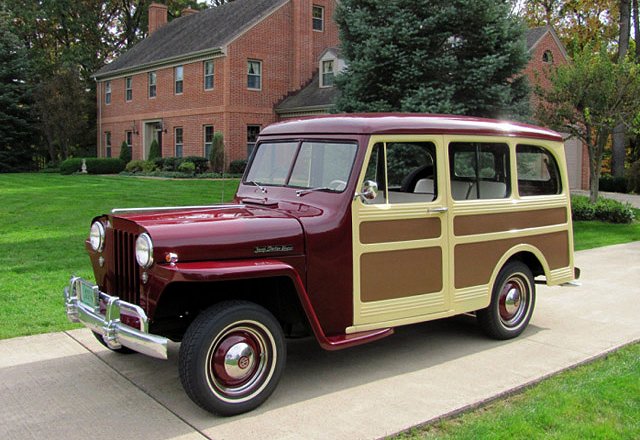Description
The Jeep Willys Station Wagon 463 was a pioneering vehicle in the history of the American automobile — the world’s first all-steel station wagon designed specifically for civilian use. Introduced in 1946 and produced through the early 1950s, the Willys Station Wagon combined the rugged dependability of Jeep’s wartime heritage with the comfort and practicality of a family car. It represented one of the first attempts to blend utility and passenger refinement in a single design, effectively laying the groundwork for what would later become the modern SUV.
When Willys-Overland launched the Station Wagon, the company was best known for the military Jeep — a vehicle that symbolized toughness and simplicity. The Station Wagon carried that same spirit into civilian life but clothed it in a body that was both handsome and remarkably modern for its time. The model designation “463” referred to its engine series and wheelbase, a hallmark of Willys nomenclature.
The design was the work of industrial designer Brooks Stevens, whose clean, functional aesthetic defined much of mid-century American automotive styling. The Willys Station Wagon featured straight lines, a tall greenhouse, and a two-box profile that maximized interior space. The front end carried the familiar Jeep vertical grille, flanked by round headlamps and a short, flat bonnet. The rest of the body was characterized by simplicity and strength — flat panels, pronounced wheel arches, and minimal ornamentation. Painted steel panels were cleverly arranged to mimic traditional wood-bodied station wagons, giving the vehicle the charm of a “woody” without the maintenance and cost of real timber.
Built on a strong ladder-type steel frame, the 463 Station Wagon was engineered for durability and ease of repair. It featured independent front suspension with transverse leaf springs — a design unusual for the time, offering a smoother ride than most competitors — and a solid rear axle with semi-elliptic leaf springs. The high ground clearance and sturdy construction gave it a robustness rare among passenger cars of the era, while the steel body made it safer, quieter, and more weather-resistant than the wooden wagons it replaced.
Power for the 463 came from Willys’ “Go-Devil” four-cylinder engine, the same reliable 2,199 cc (134 cu in) side-valve unit that powered the wartime Jeep. It produced around 63 horsepower and 142 Nm of torque, driving the rear wheels through a three-speed manual gearbox with synchromesh on the upper gears. In 1948, Willys added the option of the more powerful “Lightning” six-cylinder engine, a 2.6-litre (161 cu in) flathead that increased output to 75 horsepower, improving both top speed and hill-climbing ability.
While the drivetrain remained simple, the 463 Station Wagon offered impressive versatility. It could seat up to seven passengers, depending on configuration, with folding rear seats that created a flat load floor for cargo. The large rear tailgate, split horizontally, provided easy access to the luggage compartment, while the tall roofline ensured ample headroom. For families, small businesses, and rural drivers, it was an ideal all-purpose vehicle — as capable of carrying goods as it was people.
Inside, the Willys Station Wagon’s cabin reflected the company’s practical philosophy. The dashboard was straightforward, with large circular gauges and durable metal finishes. The seats were upholstered in simple but durable vinyl or cloth, and the interior panels were painted rather than trimmed, making them easy to clean. Ventilation and visibility were excellent thanks to the large windows and vent wings, and though it lacked luxury, the Station Wagon’s interior had a sense of honest utility.
On the road, the 463 drove much like a Jeep-derived vehicle — sturdy, deliberate, and predictable. The four-cylinder engine provided adequate power for its era, though acceleration was modest. What it lacked in outright speed, it made up for in toughness: the Willys could handle rough rural roads, muddy tracks, and snow with far greater confidence than most passenger cars. Its ride quality was firm but surprisingly controlled, and its high seating position offered commanding visibility, making it feel secure and capable.
In 1949, Willys introduced a four-wheel-drive version of the Station Wagon, creating one of the earliest family vehicles with true off-road capability. This addition transformed the model’s appeal, extending its use from suburban streets to mountain trails and farms. The 4×4 Station Wagon became especially popular in rural America, Latin America, and parts of Europe — wherever reliability and versatility were valued over refinement.
The Willys Station Wagon 463 played a crucial role in redefining what a family vehicle could be. It blurred the lines between car and truck, combining comfort, load-carrying ability, and ruggedness in a way that foreshadowed the utility vehicles and SUVs of the decades to come. It also became the basis for several derivatives, including the Willys Jeep Truck and the later Jeep Utility Wagon.
By the early 1950s, the Station Wagon’s influence was clear: it had inspired competitors such as the Chevrolet Suburban and paved the way for vehicles like the International Harvester Travelall. More than 300,000 Willys wagons were built between 1946 and 1965, many of which continued to serve for decades, a testament to their durability and simplicity.
Today, the Jeep Willys Station Wagon 463 stands as one of the most important vehicles in Jeep’s evolution. Collectors value it not only for its rugged charm and classic styling but for its pivotal place in automotive history as one of the first truly multi-purpose vehicles. Restored examples capture the spirit of postwar America — optimistic, practical, and ready for adventure.
The 463 was more than just a family wagon; it was a symbol of transition — from war to peace, from work to leisure, from the utilitarian Jeep to the modern SUV. It combined the toughness of a soldier’s vehicle with the promise of civilian freedom, proving that a car could be both a tool and a companion. In that sense, the Willys Station Wagon 463 was not just ahead of its time — it defined the time to come.

